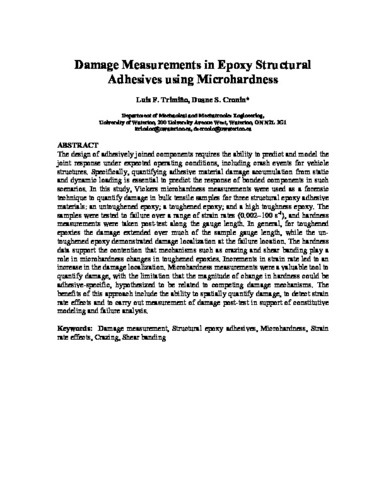| dc.contributor.author | Trimiño, Luis | |
| dc.contributor.author | Cronin, Duane | |
| dc.date.accessioned | 2023-03-08 16:34:10 (GMT) | |
| dc.date.available | 2023-03-08 16:34:10 (GMT) | |
| dc.date.issued | 2018-04 | |
| dc.identifier.uri | https://doi.org/10.1016/j.ijadhadh.2018.01.014 | |
| dc.identifier.uri | http://hdl.handle.net/10012/19192 | |
| dc.description | This preprint has not undergone peer review or any post-submission improvements or corrections. The Version of Record of this article is published in the International Journal of Adhesion and Adhesives, and is available online at https://doi.org/10.1016/j.ijadhadh.2018.01.014 | en |
| dc.description.abstract | The design of adhesively joined components requires the ability to predict and model the
joint response under expected operating conditions, including crash events for vehicle
structures. Specifically, quantifying adhesive material damage accumulation from static
and dynamic loading is essential to predict the response of bonded components in such
scenarios. In this study, Vickers microhardness measurements were used as a forensic
technique to quantify damage in bulk tensile samples for three structural epoxy adhesive
materials: an untoughened epoxy; a toughened epoxy; and a high toughness epoxy. The
samples were tested to failure over a range of strain rates (0.002–100 s-1), and hardness
measurements were taken post-test along the gauge length. In general, for toughened
epoxies the damage extended over much of the sample gauge length, while the untoughened
epoxy demonstrated damage localization at the failure location. The hardness
data support the contention that mechanisms such as crazing and shear banding play a
role in microhardness changes in toughened epoxies. Increments in strain rate led to an
increase in the damage localization. Microhardness measurements were a valuable tool to
quantify damage, with the limitation that the magnitude of change in hardness could be
adhesive-specific, hypothesized to be related to competing damage mechanisms. The
benefits of this approach include the ability to spatially quantify damage, to detect strain
rate effects and to carry out measurement of damage post-test in support of constitutive
modeling and failure analysis. | en |
| dc.description.sponsorship | The authors would like to thank 3M Company, Initiative for Advanced Manufacturing Innovation, and Automotive Partnerships Canada for providing financial support for this research. | en |
| dc.language.iso | en | en |
| dc.publisher | Elsevier ScienceDirect | en |
| dc.relation.ispartofseries | International Journal of Adhesion and Adhesives; | |
| dc.subject | damage measurement | en |
| dc.subject | structural epoxy adhesives | en |
| dc.subject | microhardness | en |
| dc.subject | strain rate effects | en |
| dc.subject | crazing | en |
| dc.subject | shear banding | en |
| dc.title | Damage Measurements in Epoxy Structural Adhesives using Microhardness | en |
| dc.type | Article | en |
| dcterms.bibliographicCitation | Trimiño, L. F., & Cronin, D. S. (2018). Damage measurements in epoxy structural adhesives using microhardness. International Journal of Adhesion and Adhesives, 82, 211–220. https://doi.org/10.1016/j.ijadhadh.2018.01.014 | en |
| uws.contributor.affiliation1 | Faculty of Engineering | en |
| uws.contributor.affiliation2 | Mechanical and Mechatronics Engineering | en |
| uws.typeOfResource | Text | en |
| uws.peerReviewStatus | Reviewed | en |
| uws.scholarLevel | Faculty | en |

